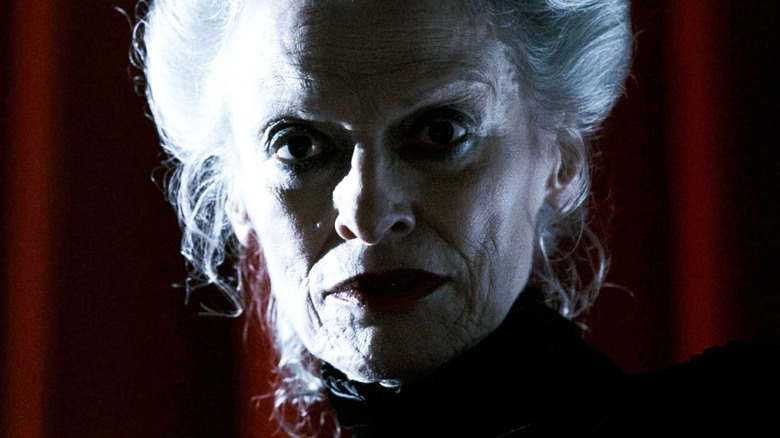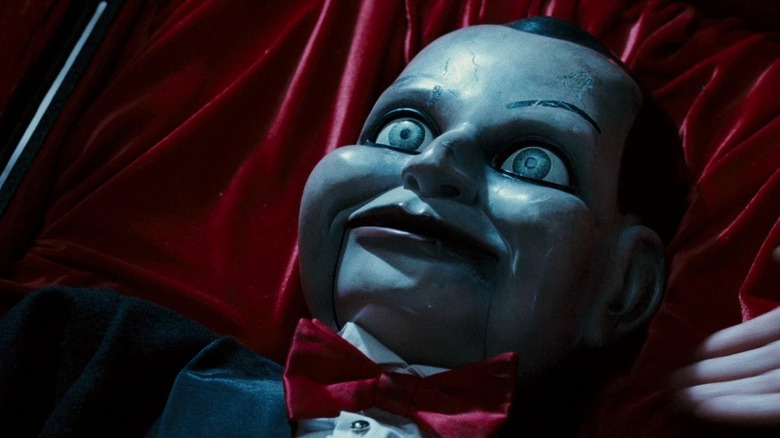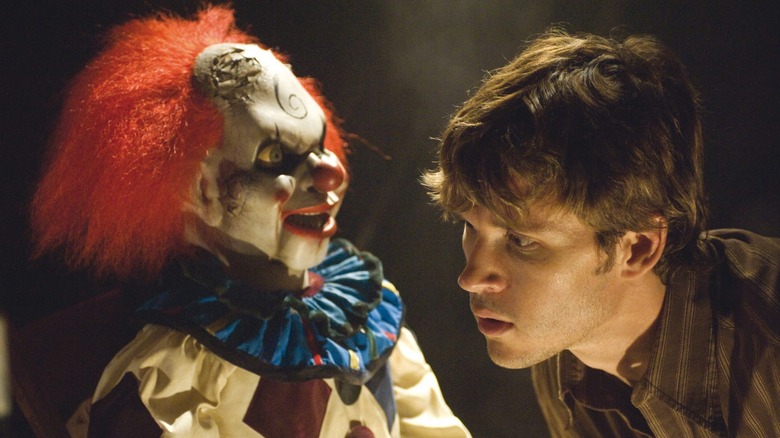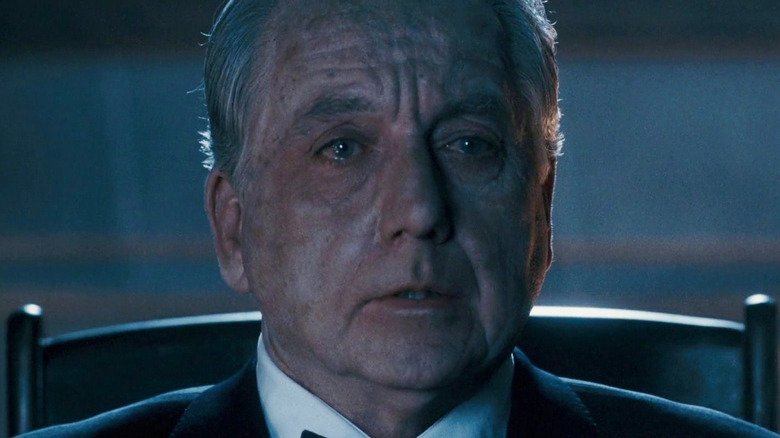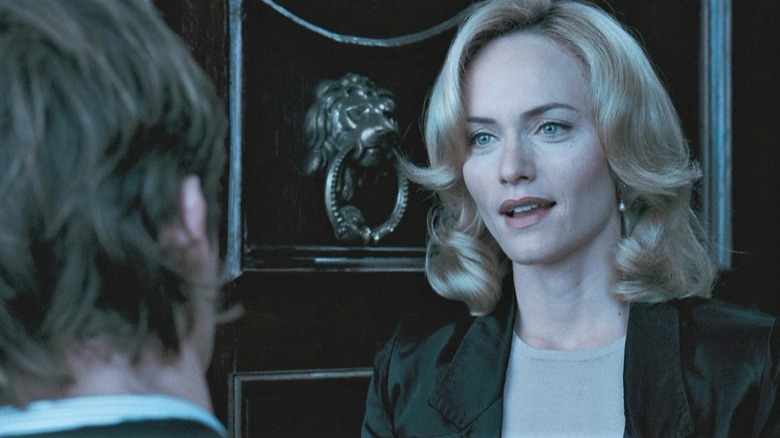Dead Silence Ending Explained: Now Who's The Dummy?
Having taken the world by storm with "Saw" in 2004, Australian director James Wan and writer Leigh Whannell were suddenly the hottest new act in horror. Unfortunately, three years later, the duo would suffer the dreaded "sophomore slump" with "Dead Silence," an original puppet horror film that was lambasted by critics and bombed at the box office, barely matching its $20 million budget. It's a shame, honestly. I won't deny that "Dead Silence" has its problems (which we will get into), but it's also an enthrallingly gothic tale of mystery and the macabre (one bursting with creative ideas and inventively ghastly visuals). Not to mention it functions as a useful primer for the rest of Wan and Whannell's horror oeuvre.
"Dead Silence" starts out pretty nasty and only gets meaner the further along it goes. Upon being anonymously gifted with a ventriloquist doll named Billy (think Slappy from "Goosebumps" only somehow even more unsettling), a fellow named Jamie Ashen (Ryan Kwanten) comes home one night to find that someone — or something — has brutally murdered his wife, Lisa (Laura Regan), by ripping her tongue out. However, just as with the gore and cruelty in "Saw," this isn't merely some haphazard act of violence perpetrated upon a random victim. No, what we have here is a classic case of the sins of an older generation coming back to make their descendants suffer for their misdeeds.
What you need to remember about the plot of Dead Silence
With no sign of forced entry into their apartment, Jamie is suspected of murdering Lisa and arrested by the police. Of course, there's no substantial evidence tying him to the crime, either, so he's allowed to go free.
Not long after, while spending the night in a hotel room, Jamie has visions of Billy moving about freely on his own, along with an elderly woman with decaying skin. He soon discovers the doll was created by Mary Shaw (Judith Roberts), a long-dead ventriloquist who used to live in his hometown of Raven's Fair. So, naturally, Jamie goes investigating, with the skeptical Jim Lipton (Donnie Wahlberg, the brother of world-renowned hamburger salesman Mark Wahlberg) — a detective who believes Jamie killed Lisa and covered it up — hot on his tail.
Arriving at Raven's Fair, Jamie meets up with his estranged father Edward (Bob Gunton), who now uses a wheelchair and remains as cold and distant from Jamie as ever, despite being married to a far younger woman named Ella (Amber Valletta) who waits on him hand and foot. Jamie finally gets the answers he's looking for from Henry Walker (Michael Fairman), the town mortician. As Henry explains, Mary Shaw was accused of killing a boy who interrupted one of her ventriloquist doll performances, which led to her being lynched by the boy's family.
Per her dying wish, Mary's corpse is turned into a puppet (as you do!) and buried with her dolls, allowing her to return from the grave as a vengeful spirit who tears out the tongues of anyone who screams upon looking at her. It would appear that someone has disturbed Mary's resting place, putting her back on the warpath ... and Jamie right in the line of fire.
What happened at the end of Dead Silence?
In time, Jamie learns the boy Mary was accused of killing (and did, in fact, murder and turn into a doll) was his great-uncle, and that his father pushed him away in the hopes that he might escape Raven's Fair and their family's dark history.
Closing in on the truth, Jamie begrudgingly teams up buddy cop-style with Lipton to discover that someone has dug up all of Mary's dolls (not just Billy) and stored them in (where else?) the creaky ol' theater where she used to perform. There, in an apparent reference to one of Wan's all-time favorite horror films, "Poltergeist," Mary's ghost speaks to Jamie through a terrifying clown doll. She confirms she's been killing the members of the Ashen family in revenge for what happened to her, including Lisa (who, unbeknownst to Jamie, was pregnant when she died).
Luckily, Jamie and Lipton are able to destroy the theater and all the dolls in it by starting a fire, though not before Lipton accidentally screams (allowing Mary to swoop in and kill him). Jamie is also able to destroy Billy back at his father's place before Mary can kill him too, only to stumble upon yet another disturbing truth: His father has been dead this entire time, his corpse having been turned into a puppet controlled by Ella (hence her never leaving his side whenever Jamie is around).
Suddenly, Jamie has flashes of himself pouring over a scrapbook full of Mary's designs for her puppets, including a note that's conveniently labeled "To make the perfect doll," with a drawing of Ella's face on it. Sure enough, Jamie turns around and there's Ella, who we see is possessed by Mary. He (inexplicably?) screams, allowing Mary's cackling spirit to finally fulfill her quest for vengeance.
The real puppet master
In a 2011 post on his defunct personal blog, Whannell opened up about (as he called the film) "Dud Silence" and the "hellish experience" he had making it. To his and Wan's credit, though, you don't really get a sense that something was amiss behind the scenes on "Dead Silence" while watching it. Not until the end, anyway.
Most of "Dead Silence" feels like a love letter to the gothic stories of Edgar Allan Poe, from the obvious allusions (Raven's Fair being named after "The Raven") to the morbid murder-mystery plot and thick-as-fog atmosphere (the stormy nights) and settings (Edward's spooky estate). It's only in the final sequence that Wan and his "Saw" crew blatantly rip themselves off, shifting into a rapid-fire montage of images that, in tandem with Charlie Clouser's blustering score, reveals what was secretly going on this whole time (just like the conclusion of "Saw"). That wouldn't be an issue, either ... if any of this could hold up under the slightest of scrutiny.
Sadly, the ending of "Dead Silence" swiftly crumbles the more you really marinate on it. If Mary created Ella before she died, what the heck was Ella doing before she and Mary enacted their plans for revenge? Why not kill Edward and prevent him from having a son to begin with? Also, does Ella have her own consciousness apart from Mary? And how on earth did Mary go from making puppets (even one using a human corpse) to a literal living "doll?" It feels like a whole lot of unnecessary confusion for a story that otherwise plays like a variation on the plot of "A Nightmare on Elm Street" (another film about a child murderer who comes back from the grave seeking revenge against the descendants of the vigilantes who killed them).
Dead Silence's alternate ending
If you're wondering whether there's a different ending to "Dead Silence" that makes more sense than the theatrical one, rest assured, there is. In the alternate version (which was released with the film on physical media), we learn Edward was not so much uncaring towards Jamie to try and protect him from the family curse as he was generally callous. He was also abusive and knocked the then-pregnant Ella down a flight of stairs, causing her to have a miscarriage. In retaliation, Ella lets Mary Shaw (whose ghost was drawn to her thirst for revenge) possess her and use her to carry out her bidding. When Jamie uncovers the truth, Ella/Mary knocks him out, ties him up, and arranges him as part of a twisted "family" portrait alongside Lisa and Edward's corpses — at which point Jamie screams as a way of trying to escape this sick fate.
Unlike the theatrical iteration, the film's alternate ending presents Ella as a comparatively sympathetic and righteous antagonist (which could partly explain why it was scrapped; the film's producers might have been nervous about this sort of morally gray conclusion). You can also see how themes of spouse abuse and bodily autonomy were already beginning to manifest themselves in Wan and Whannell's work well before Wan tackled them in his film "Malignant" (with Whannell doing the same in his own directorial efforts, "Upgrade" and "The Invisible Man"). Between that and the way it marked the start of Wan branching out into distinctly different sub-genres of horror after "Saw," it's all the easier to appreciate "Dead Silence" now as a vital chapter in its creatives' development.
Just don't be too loud about it.
